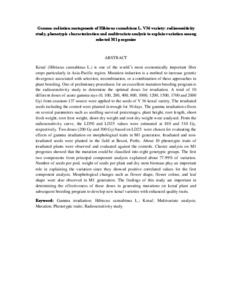Citation
Sani, Mohd Zulmadi and Ahmad, Faiz and Akil, Mustapha and Ahmad, Zaiton and Abu Hassan, Affrida and Harun, Abdul Rahim and Yusop, Mohd Rafii
(2017)
Gamma-radiation mutagenesis of Hibiscus cannabinus L. V36 variety: radiosensitivity study, phenotypic characterization and multivariate analysis to explain variation among selected M1 progenies.
Jurnal Sains Nuklear Malaysia, 29 (2).
pp. 21-32.
ISSN 2232-0946
Abstract
Kenaf (Hibiscus cannabinus L.) is one of the world’s most economically important fiber crops particularly in Asia-Pacific region. Mutation induction is a method to increase genetic divergence associated with selection, recombination, or a combination of these approaches in plant breeding. One of preliminary procedures for an execellent mutation breeding program is the radiosensitivity study to determine the optimal doses for irradiation. A total of 10 different doses of acute gamma rays (0, 100, 200, 400, 800, 1000, 1200, 1500, 1700 and 2000 Gy) from ceasium-137 source were applied to the seeds of V 36 kenaf variety. The irradiated seeds including the control were planted in trough for 30 days. The gamma irradiation effects on several parameters such as seedling survival percentages, plant height, root length, shoot fresh weight, root frest weight, shoot dry weight and root dry weight were analysed. From the radiosensitivity curve, the LD50 and LD25 values were estimated at 810 and 310 Gy, respectively. Two doses (200 Gy and 300 Gy) based on LD25 were chosen for evaluating the effects of gamma irradiation on morphological traits in M1 generation. Irradiated and non-irradiated seeds were planted in the field at Beseri, Perlis. About 10 phenotypic traits of irradiated plants were observed and evaluated against the controls. Cluster analysis on M1 progenies showed that the mutation could be classified into eight genotypic groups. The first two components from principal component analysis explained about 77.99% of variation. Number of seeds per pod, weight of seeds per plant and dry stem biomass play an important role in explaining the variation since they showed positive correlated values for the first component analysis. Morphological changes such as flower shape, flower colour, and leaf shape were also observed in M1 generation. The findings of this study are important in determining the effectiveness of these doses in generating mutations on kenaf plant and subsequent breeding program to develop new kenaf varieties with enhanced quality traits.
Download File
![[img]](http://psasir.upm.edu.my/12756/1.hassmallThumbnailVersion/Gamma-radiation%20mutagenesis%20of%20Hibiscus%20cannabinus%20L.%20V36%20variety.pdf)  Preview |
|
Text (Abstract)
Gamma-radiation mutagenesis of Hibiscus cannabinus L. V36 variety.pdf
Download (54kB)
| Preview
|
|
Additional Metadata
Actions (login required)
 |
View Item |

